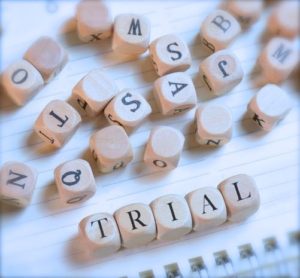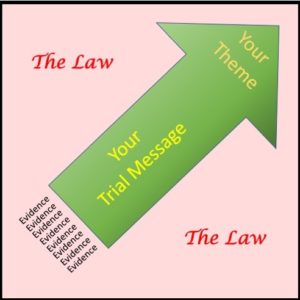By Dr. Ken Broda Bahm:

Trial lawyers understand the need to refine and to help fit the main point of their case into the smallest possible container. In complex litigation, however, that quest for a bottom line can be elusive. You might have your one-line theme, and as much as that single expression can help to focus your case, chances are good that you’ll need more from your fact-finders. The actual message will be a bit broader. I call that broader focus a “trial message.” It is still concise, but it aims to represent the substantive thrust of your case in a way that is more comprehensive than your trial theme.
So your trial message is going to be somewhere in between: less than the sum total of your case, but more than the single line of your theme. It should be a discrete list of conclusions you need your juror or judge to reach in order to side with you in the case. In a medical professional liability defense, for example, your theme might be a simple idea like, “We can only treat what we can observe.” The trial message, however, could be a list of a half-dozen to a dozen conclusions relating to standard of care and liability, to causation, to contributory negligence, to damages, or to other issues. This is an important list for attorneys to think about. If you’re standing on top of a mountain of evidence with just a pithy theme, then you’ve missed a step in between. A well-considered trial message gives you a chance to organize that mountain into a finite set of molehills. And even if you don’t go to trial, that trial message is helpful in focusing your discovery, outlining your deposition examinations, framing your briefs, and in assessing your case for potential settlement. In this post, I’ll take a look at what a trial message is and share an example.
What’s a Trial Message?
Your trial message is a discrete listing of all the conclusions you need to get your jurors or other fact-finders to accept as their own. The single message of the theme might be thought of as the tip of the spear, but the trial message is what provides the heft behind that tip. The trial message is what the fact-finders go to once they dig a bit deeper than the theme. Ultimately, the evidence is what backs all of it up and the law is what gives it relevance.
Here is one way to visually represent it.

Your message will clearly be informed by the legal elements that you need to prove, or to prevent the other side from proving, but will also address the human elements that would be necessary for listeners to see your case as clear, credible, and compelling.
You might develop this list as you learn the challenges of your case, and you will likely supplement the list over time as you learn reactions from colleagues and from mock jurors in the event that you’re able to test your case.
An Example
The best indication of what I mean by a trial message comes from an example. Taking a generic and somewhat fictionalized version of a recent case I’ve been working on, let me illustrate the idea.
The theme: “We can test, and we can warn, but we cannot make choices for the user.”
The trial message:
-
-
- We are a good company
- We have a commitment to safety
- We take care to design products that are as safe as they can be
- We test products thoroughly
- We meet or exceed all relevant regulations
- We monitor products once they’re on the market to be aware of any problems
- Our own profit motive causes us to want the safest product possible
- The only liability in this case would be based on negligence, and we were not negligent
- This product can be relatively safe, but some level of risk is inherent in the nature of the product
- We provide clear warnings on these inherent dangers
- The injury in this case was caused by the user’s failure to take reasonable care
- The plaintiff’s claimed damages are overstated
-
Of course, in trial, you would share a lot of information, but the idea is that all of it would go into one of these 12 buckets. In this way, the exercise of sitting down and coming up with a focused and manageable list for your trial message is helpful in focusing your case.
_____
Other Posts on Your Message:
- Deploy Your Trial Message When It Matters Most: Pretrial
- Consider What Drives Resistance to Your Message
- Chunk Your Trial Message